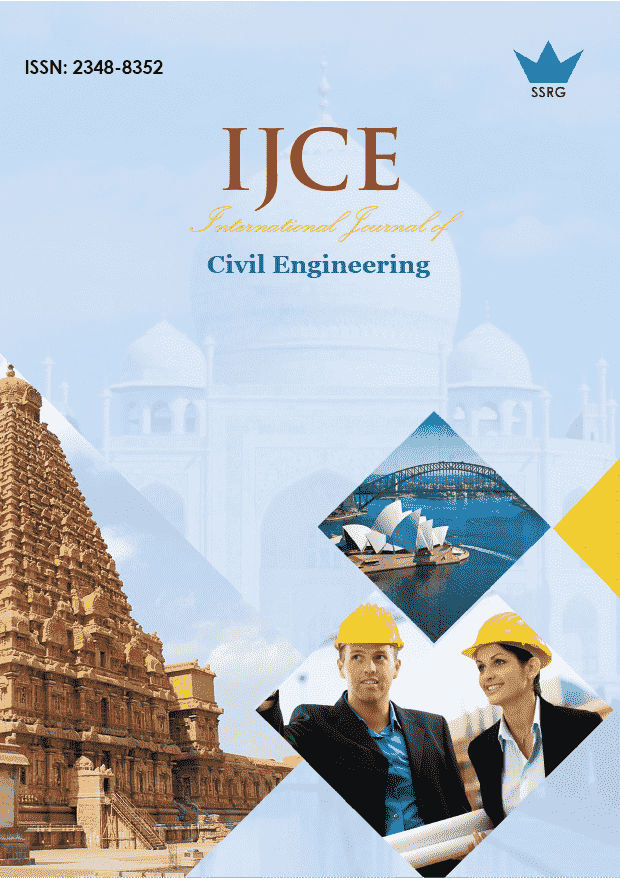Evaluation of an Existing RBC Plant in Egypt

| International Journal of Civil Engineering |
| © 2025 by SSRG - IJCE Journal |
| Volume 12 Issue 4 |
| Year of Publication : 2025 |
| Authors : Alaa Adel Mouneer, Mohamed El Hosseiny El Nadi, Ghada M. Nazir Bassouini |
How to Cite?
Alaa Adel Mouneer, Mohamed El Hosseiny El Nadi, Ghada M. Nazir Bassouini, "Evaluation of an Existing RBC Plant in Egypt," SSRG International Journal of Civil Engineering, vol. 12, no. 4, pp. 8-17, 2025. Crossref, https://doi.org/10.14445/23488352/IJCE-V12I4P102
Abstract:
Rotating biological contactors technology is one of the applied wastewater treatment technologies in Egyptian rural areas. RBC plants’ performance in Egypt falls below the expected standards from their design criteria. This study investigates the causes of deterioration and the problems facing RBC technology in Egypt. This was achieved through reviewing and evaluating the existing situation for El-Manayel WWTP, including design review and evaluation of existing structure status for plant units, as well as evaluation of the applied operation and maintenance procedure. The study’s findings revealed that the treatment units could achieve their designed effluent results for a short period only; after this period, the biological treatment deteriorates because of the random operation and the lack of preventive maintenance. The major detected problems were the repetitive mechanical equipment failures, and using non-durable materials for the replaced parts during performing the corrective maintenance. It has been proven that the design of the plant’s treatment units is suitable for the incoming influent, adequate for the local climate, and capable of achieving the required effluent quality, complying with the Egyptian law no.48 of 1982 concerning the protection of the Nile and the water channels against pollution.
Keywords:
Wastewater, Rotating Biological Contactors, RBC, Biological wastewater treatment, O&M.
References:
[1] Sanjay Dutta, Mathematical Modeling of the Performance of a Rotating Biological Contactor for Process Optimisation in Wastewater Treatment, Verlag Siedlungswasserwirtschaft, pp. 1-224, 2007.
[Google Scholar] [Publisher Link]
[2] Frank R. Spellman, Handbook of Water and Wastewater Treatment Plant Operations, 3rd ed., Taylor & Francis, pp. 1-923, 2013.
[Google Scholar] [Publisher Link]
[3] Rumana Riffat, and Taqsim Husnain, Fundamentals of Wastewater Treatment and Engineering, 2nd ed., CRC Press, pp. 1-430, 2022.
[CrossRef] [Google Scholar] [Publisher Link]
[4] Sharjeel Waqas, Muhammad Roil Bilad, and Zakaria B Man, “Performance and Energy Consumption Evaluation of Rotating Biological Contactor for Domestic Wastewater Treatment,” Indonesian Journal of Science and Technology, vol. 6, no. 1, pp. 101-112, 2021.
[Google Scholar] [Publisher Link]
[5] Milad Rajaei, and Sara Nazif, “Improving Wastewater Treatment Plant Performance Based on Effluent Quality, Operational Costs, and Reliability Using Control Strategies for Water and Sludge Lines,” Process Safety and Environmental Protection, vol. 167, pp. 398-411, 2022.
[CrossRef] [Google Scholar] [Publisher Link]
[6] Francis Hassard et al., “Rotating Biological Contactors for Wastewater Treatment – A Review,” Process Safety and Environmental Protection, vol. 94, pp. 285-306, 2015.
[CrossRef] [Google Scholar] [Publisher Link]
[7] Shamas Tabraiz, Sajjad Haydar, and Ghulam Hussain, “Evaluation of a Cost-Effective and Energy-Efficient Disc Material for Rotating Biological Contactors (RBC), and Performance Evaluation under Varying Condition of RPM and Submergence, Desalination and Water Treatment,” Desalination and Water Treatment, vol. 57, no. 43, pp. 20439-20446, 2015.
[CrossRef] [Google Scholar] [Publisher Link]
[8] Sharjeel Waqas et al., “Response Surface Methodology for Optimization of Rotating Biological Contactor Combined with External Membrane Filtration for Wastewater Treatment,” Membranes, vol. 12, no. 3, pp. 1-16, 2020.
[CrossRef] [Google Scholar] [Publisher Link]
[9] Eniko Gaspar, Ioan Munteanu, and Silviu Sintea, “Removal of N and P in a Rotating Biological Contactor Plant: Case Study Agnita, Romania,” Water, vol. 14, no. 22, pp. 1-13, 2022.
[CrossRef] [Google Scholar] [Publisher Link]
[10] Ahmed Tawfik et al., “Physico-Chemical Factors Affecting the Removal in a Rotating Biological Contactor (RBC) Treating UASB Effluent,” Water Research, vol. 38, no. 5, pp. 1081-1088, 2004.
[CrossRef] [Google Scholar] [Publisher Link]
[11] Mahetab Hanafy, Hanan Fouad, and Rehab Elhefny, “Rotating Biological Contactor Wastewater Treatment Using Geotextiles, Sugarcane Straw and Steel Cylinder for Green Areas Irrigation,” Egyptian Journal of Chemistry, vol. 65, no. 6, pp. 59-72, 2022.
[CrossRef] [Google Scholar] [Publisher Link]
[12] American Public Health Association, Standard Methods for the Examination of Water and Wastewater, American Public Health Association, pp. 1-724, 2012.
[Google Scholar] [Publisher Link]

 10.14445/23488352/IJCE-V12I4P102
10.14445/23488352/IJCE-V12I4P102